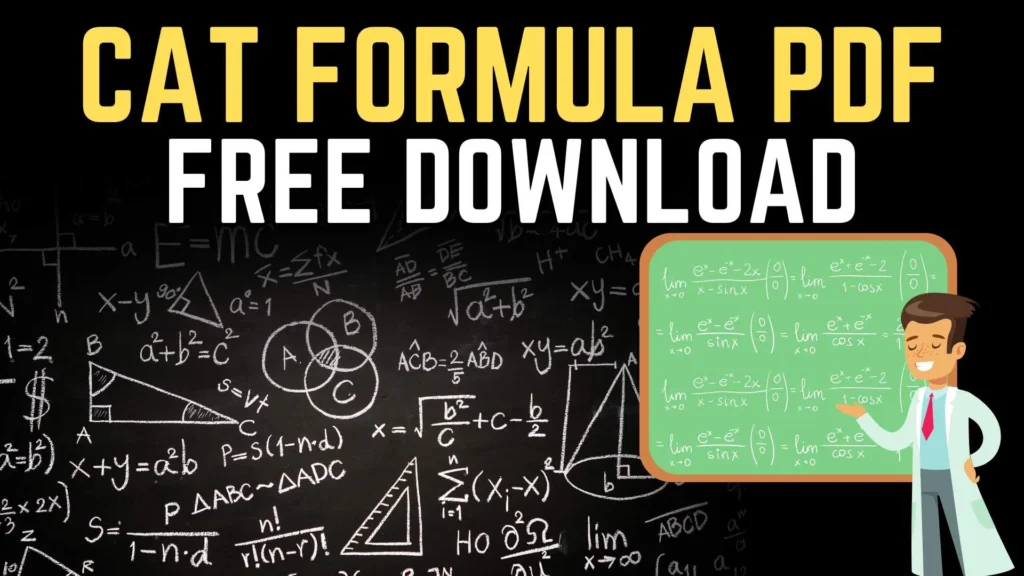Download Free CAT Formulas PDF
The following information is compilation of all the free resources available online. The credit goes to all the original content creators. Do share the same with your fellow CAT aspirants. Mugging up formulas will definitely help crack CAT or any other entrance exam. The best way to use them is to understand the logic and how it is deduced.

Quantitative Aptitude Formulas for CAT
1. CAT Arithmetic
Time, Speed, and Distance:
– Speed = Distance / Time
– Distance = Speed × Time
– Time = Distance / Speed
– Average Speed = Total Distance / Total Time
– Relative Speed (Opposite direction) = Speed₁ + Speed₂
– Relative Speed (Same direction) = |Speed₁ – Speed₂|
Work and Time:
– Work Done = Rate × Time
– Rate of Work = 1 / Time Taken
– Combined Work Rate (Two people) = (1/Time₁ + 1/Time₂)
– Time taken together = (Time₁ × Time₂) / (Time₁ + Time₂)
For pipes and cisterns:
– Net Rate of Filling = Filling rate – Emptying rate
Mixtures and Alligations:
– (C₁ – Mean Price) / (Mean Price – C₂) = Quantity of C₂ / Quantity of C₁
Profit, Loss, and Discount:
– Profit % = (Profit / Cost Price) × 100
– Loss % = (Loss / Cost Price) × 100
– Discount % = (Discount / Marked Price) × 100
– Selling Price = Cost Price ± Profit (or Loss)
– Net Successive Discount = D₁ + D₂ – (D₁ × D₂) / 100
Simple Interest (SI) and Compound Interest (CI):
– Simple Interest = (P × R × T) / 100
– Compound Interest = P(1 + R/100)ⁿ – P
Percentages:
– Percentage Change = [(New Value – Old Value) / Old Value] × 100
2. CAT Algebra
Linear Equations:
– Two equations:
ax + by = c
dx + ey = f
Solve using substitution or elimination.
Quadratic Equations:
– x = [-b ± √(b² – 4ac)] / 2a
Discriminant (D) = b² – 4ac
– D > 0: two real and distinct roots
– D = 0: two real and identical roots
– D < 0: no real roots
Progressions:
– nth term of an AP = a + (n – 1)d
– Sum of n terms of an AP = n/2 × [2a + (n – 1)d]
– nth term of a GP = a × rⁿ⁻¹
– Sum of n terms of GP = a(1 – rⁿ) / (1 – r)
(If |r| < 1, Sum to infinity = a / (1 – r))
3. CAT Geometry and Mensuration Formulas
Triangles:
– Area = ½ × base × height
– Heron’s Formula: Area = √[s(s-a)(s-b)(s-c)]
where s = (a + b + c) / 2
– Pythagoras Theorem: a² + b² = c²
Circles:
– Circumference = 2πr
– Area = πr²
– Arc Length = (θ / 360) × 2πr
– Sector Area = (θ / 360) × πr²
Polygons:
– Sum of Interior Angles = 180(n-2)
– Each Exterior Angle = 360 / n (for regular polygons)
Cylinders:
– Volume = πr²h
– Surface Area = 2πrh + 2πr²
Cones:
– Volume = (1/3)πr²h
– Surface Area = πr(l + r) (where l = slant height)
Spheres:
– Surface Area = 4πr²
– Volume = 4/3 πr³
Cuboid:
– Volume = l × b × h
– Surface Area = 2(lb + bh + lh)
Pyramids:
– Volume = (1/3) × Base Area × Height
4. CAT Number System Formulas
Divisibility Rules:
– Divisible by 2: last digit is even.
– Divisible by 3: sum of digits divisible by 3.
– Divisible by 5: last digit is 0 or 5.
LCM and HCF:
– LCM × HCF = Product of the two numbers
– HCF (Euclidean method): Subtract the smaller number from the larger one and repeat.
Prime Numbers:
– Prime numbers have only two factors: 1 and itself.
– To check if n is prime, divide by primes ≤ √n.
Fermat’s Little Theorem:
– If p is prime, then for any integer a:
a^(p-1) ≡ 1 (mod p)
Euler’s Theorem:
– If a and n are co-prime:
a^(ϕ(n)) ≡ 1 (mod n)
where ϕ(n) is Euler’s totient function.
Remainder Theorem:
– If a, b, c are prime factors of N:
ϕ(N) = N × (1 – 1/a) × (1 – 1/b) × (1 – 1/c)
Permutations & Combinations:
– nPr = n! / (n-r)!
– nCr = n! / [r!(n-r)!]
5. CAT Probability Formulas
– P(A) = Number of favorable outcomes / Total number of outcomes
– For independent events:
P(A and B) = P(A) × P(B)
– For mutually exclusive events:
P(A or B) = P(A) + P(B)
Let’s dive into the second section of the article focused on Data Interpretation (DI) Formulas for CAT 2024. Data Interpretation often relies on quick calculations and a solid grasp of basic math concepts. In CAT, DI problems typically involve interpreting data from graphs, tables, and charts, and then using mathematical operations to analyze them. While DI is less formula-heavy than Quant, mastering key formulas and techniques will give you a significant edge in solving questions faster.
Data Interpretation (DI) Formulas for CAT 2025
Data Interpretation (DI) requires a solid foundation in calculations involving percentages, averages, and ratios. While there aren’t as many formulas as in Quantitative Aptitude, knowing the right shortcuts and methods for analysis is essential.
Key Concepts and Formulas in DI:
1. Percentages
Percentages are the backbone of many DI problems, especially in charts and tables that involve percentage growth, comparison, and profit/loss.
– Percentage = (Part / Whole) × 100
– Used to calculate what portion of the total is represented by a given value.
– Percentage Change = [(New Value – Old Value) / Old Value] × 100
– Use this formula to calculate the percentage increase or decrease between two values.
– Percentage Increase = (Increase / Original Value) × 100
– Percentage Decrease = (Decrease / Original Value) × 100
_Example: If a company’s revenue increased from ₹500,000 to ₹600,000, the percentage increase is [(600,000 – 500,000) / 500,000] × 100 = 20%._
2. Ratio and Proportion
Ratios are vital in DI, especially when comparing different data sets. You’ll often need to determine how one quantity compares to another.
– Ratio = Quantity₁ / Quantity₂
– Often expressed as a:b, which means a divided by b.
– Proportion: If two ratios are equal, they are in proportion. For example, a:b = c:d, or
a/b = c/d, then the four quantities are proportional.
_Example: In a company, the male-to-female ratio is 3:2. This means for every 3 males, there are 2 females. If there are 90 males, how many females are there? Using the proportion formula: 3/2 = 90/x → x = 60 females._
3. Averages and Weighted Averages
Averages are often tested in DI sets involving tables and pie charts. The weighted average is crucial when some data points contribute more significantly than others.
– Average = (Sum of Terms) / (Number of Terms)
– Weighted Average = (w₁x₁ + w₂x₂ + … + wₙxₙ) / (w₁ + w₂ + … + wₙ)
Where w₁, w₂, … wₙ are the weights, and x₁, x₂, … xₙ are the data points.
_Example: If a product is sold at 3 different stores with prices of ₹100, ₹200, and ₹300, and the number of units sold at these stores are 5, 3, and 2 respectively, the weighted average price is:
(100×5 + 200×3 + 300×2) / (5 + 3 + 2) = ₹166.67._
4. Speed Calculations (Quick Multiplication/Division)
Speed in performing multiplication and division is critical for DI problems, especially when calculating values from large datasets. You should practice quick mental math or use techniques such as Vedic math.
Some important mental math shortcuts:
– Multiplying by 5:
_Example: 124 × 5 = (124 × 10) / 2 = 620_
– Multiplying by 11:
_Example: 234 × 11 = 2340 + 234 = 2574_
5. Data Interpretation from Graphs
– Bar Graphs: Use ratios, percentages, and averages to compare the heights of bars representing different data sets.
– Line Graphs: Often used for tracking changes over time, apply percentage change or growth rate formulas to analyze trends.
– Pie Charts: Use percentage distribution to analyze proportions. The angle for each segment of the pie chart is calculated as:
Angle = (Value / Total Value) × 360°
_Example: If a sector in a pie chart represents 25% of the total, the corresponding angle is (25 / 100) × 360° = 90°._
6. Growth Rate
Growth rate is particularly useful in DI sets involving time-series data, such as company revenue or population growth.
– Annual Growth Rate = [(Final Value / Initial Value) ^ (1/n)] – 1
Where n is the number of years.
_Example: If a company’s revenue grew from ₹500,000 to ₹800,000 in 3 years, the growth rate is [(800,000 / 500,000)^(1/3)] – 1 ≈ 16.9% per year._
7. Compound Growth Rate (CAGR)
In questions where growth is compounded over several periods, use the Compound Annual Growth Rate (CAGR).
– CAGR = [(Ending Value / Starting Value)^(1/n)] – 1
_Example: If an investment grew from ₹10,000 to ₹20,000 in 5 years, the CAGR is [(20,000 / 10,000)^(1/5)] – 1 ≈ 14.87%._
8. Profit and Loss
Profit and loss calculations frequently appear in DI sets involving financial data.
– Profit % = (Profit / Cost Price) × 100
– Loss % = (Loss / Cost Price) × 100
_Example: If the cost price of a product is ₹150 and the selling price is ₹180, the profit percentage is:
Profit = ₹180 – ₹150 = ₹30, and Profit % = (30/150) × 100 = 20%._
9. Unitary Method
The unitary method is useful for DI problems where you need to calculate values based on given units.
– To find the value of 1 unit: Divide the total value by the number of units.
_Example: If 5 apples cost ₹100, then 1 apple costs ₹100/5 = ₹20._
Tips for Speed in CAT Data Interpretation
1. Use approximations where possible. For example, if you’re calculating 49% of a number, use 50% as a rough estimate and adjust.
2. Mental Math for basic operations like multiplying or dividing by 5, 10, 11, etc., will save you a lot of time in the exam.
3. Scan the Data Quickly: Before diving into calculations, take a quick glance at all the data to understand the relationships between different data points. This helps in identifying which values are relevant to each question.
4. Work with rounded values first, especially in large datasets, and refine the answer later if necessary.
In DI, mastering these formulas and strategies will help you break down large, intimidating data sets into manageable, bite-sized chunks. The ability to interpret graphs, tables, and charts quickly will allow you to focus on the analysis rather than getting bogged down by the numbers. Remember, DI is not just about calculations—it’s about making quick, intelligent decisions with the data at hand.
Logical Reasoning (LR) Formulas and Techniques for CAT 2024
Logical Reasoning in CAT typically tests your ability to break down complex problems, identify patterns, and make logical connections. While it may not have as many “hard” formulas, there are numerous techniques, shortcuts, and strategic approaches that will help you ace this section.
Key Concepts and Techniques in LR:
1. Deductive Logic
Deductive reasoning involves drawing specific conclusions from general premises. This is the foundation of many LR problems, especially in syllogisms and propositions.
Syllogisms:
Major Premise: A general statement.
Example: All humans are mortal._
Minor Premise: A specific statement.
Example: Socrates is a human._
Conclusion: Deductive reasoning leads to a conclusion based on the premises.
Conclusion: Socrates is mortal._
In CAT LR, you’ll often see statements like “All A are B” or “Some B are C.” You’ll need to deduce conclusions from these statements based on the logical relationships between them.
Key Techniques for Syllogisms:
– Venn Diagrams: Use Venn diagrams to visualize relationships between different sets or categories. This is particularly useful for solving problems involving “All,” “Some,” or “None.”
– Negation Method: This technique involves testing the opposite of a conclusion to see if it leads to a contradiction. If negating a conclusion causes a contradiction with the premises, the original conclusion is valid.
_Example: “All students are smart.” If you test the negation (some students are not smart), it contradicts the given statement._
Common Logical Fallacies:
– Affirming the Consequent: Assuming that if “A implies B,” then “B implies A” (which isn’t always true).
– Denying the Antecedent: Incorrectly assuming that if “A implies B” and “A is false,” then “B must also be false.”
—
2. Binary Logic
Binary logic puzzles are common in CAT. These puzzles often involve statements that are either true or false, and you need to determine the truth or falsity of multiple statements based on given conditions.
Key Techniques for Binary Logic:
– Yes/No or True/False Statements: In these puzzles, people make statements about each other or situations, and you need to figure out who is telling the truth.
Example: If A says, “I am telling the truth,” and B says, “A is lying,” you need to analyze the consistency between their statements to find the solution._
Rules for Binary Logic:
– Contradiction: If a set of statements leads to a logical contradiction, one of the statements is false.
– Elimination: Start by assuming one statement is true and work through the consequences. If it leads to an inconsistency, eliminate that assumption and try the opposite.
Example: In a group of three people (A, B, and C), A says, “B is lying,” B says, “C is lying,” and C says, “A is lying.” You must use logical elimination to determine who is lying.
3. Set Theory and Venn Diagrams
Set theory plays an important role in solving Logical Reasoning problems, especially when dealing with groups, overlapping categories, or distribution-based problems.
Basic Set Theory Operations:
– Union of Sets (A ∪ B): The union of two sets includes all elements from both sets.
Example: If Set A contains {1, 2, 3} and Set B contains {3, 4, 5}, then A ∪ B = {1, 2, 3, 4, 5}.
– Intersection of Sets (A ∩ B): The intersection of two sets contains only the elements common to both sets.
Example: If Set A contains {1, 2, 3} and Set B contains {3, 4, 5}, then A ∩ B = {3}.
Key Formulas for Set Theory:
– n(A ∪ B) = n(A) + n(B) – n(A ∩ B)
This formula calculates the number of elements in the union of two sets.
Example: If there are 50 people in a class, 30 play football, and 25 play basketball, and 10 play both, then the total number of people who play either football or basketball is 30 + 25 – 10 = 45.
– For Three Sets (A, B, C):
n(A ∪ B ∪ C) = n(A) + n(B) + n(C) – n(A ∩ B) – n(B ∩ C) – n(C ∩ A) + n(A ∩ B ∩ C)
Venn Diagrams:
Venn diagrams are graphical representations of sets and their relationships. In CAT, they are used to visualize problems involving multiple groups and overlaps.
—
4. Puzzles and Arrangements
Puzzles are a big part of Logical Reasoning in CAT, especially those involving seating arrangements, ordering, and distribution. Solving these puzzles requires breaking them down into smaller steps.
Seating Arrangements:
– Linear Arrangement: People or objects are seated in a straight line.
– If people are seated in a row, pay attention to terms like “next to,” “immediately left of,” or “second from the right.”
– Circular Arrangement: People or objects are seated around a circle.
– In circular arrangements, direction matters (clockwise vs. counterclockwise).
Techniques for Solving Puzzles:
– Draw Diagrams: Visualize the arrangement with diagrams. For circular arrangements, start by placing one person or object and work around the circle.
– Work from Fixed Points: If a problem gives you a fixed point (e.g., “Person A is seated at the leftmost seat”), use that as a reference to position other elements.
– Use Elimination: If a particular arrangement contradicts any given clue, eliminate that possibility and try another configuration.
Distribution-Based Puzzles:
These involve distributing items among different groups or people according to given conditions.
– Use tables or grids to track which elements belong to which group.
Example: Distribute five people among three teams based on their preferences. Set up a table that tracks who can or cannot be in each team._
—
5. Logical Sequences and Series
Logical reasoning often includes sequences or patterns, where you are asked to identify the next number or object in a sequence.
Arithmetic and Geometric Sequences:
– Arithmetic Sequence: Each term is obtained by adding a fixed number to the previous term.
Formula: nth term = a + (n – 1)d
where a = first term, d = common difference.
– Geometric Sequence: Each term is obtained by multiplying the previous term by a fixed number.
Formula: nth term = a × rⁿ⁻¹
where a = first term, r = common ratio.
Pattern Recognition:
Look for patterns in sequences involving shapes, numbers, or letters.
Example: In the sequence 2, 4, 8, 16, the pattern is multiplying by 2. The next number will be 32._
—
6. Blood Relations
Blood relation questions involve determining family relationships based on given information. These can be tricky but become easier if you use diagrams to map out relationships.
Key Terms:
– Brother/Sister: Sibling relationships.
– Parent/Child: Direct lineage.
– Uncle/Aunt: Brother or sister of one’s parent.
– Grandparent: Parent of one’s parent.
Techniques for Blood Relations:
– Use Symbols: Use symbols to represent male (M), female (F), and unknown genders (?) in diagrams.
– Work Through Levels: Start with the base generation (e.g., parents) and work through each generation step by step.
—
Conclusion:
Logical Reasoning (LR) in CAT is all about practicing different types of puzzles and developing a strong understanding of logical patterns, deductive reasoning, and set theory. While you won’t use formulas as much in LR as you do in Quant, mastering techniques such as Venn diagrams, binary logic, and logical sequences will greatly improve your accuracy and speed in solving these questions.
The key to excelling in LR is to stay organized, work methodically, and practice regularly to sharpen your logical thinking skills. Whether it’s seating arrangements, binary logic, or set theory, familiarity with these tools will make solving even the most complex problems easier during the CAT exam.
Tips for Efficient Formula Memorization
Okay, let’s get real for a second—memorizing formulas is HARD. You think you’ve got it down, and then two days later, poof, it’s gone. Trust me, we’ve all been there. When I was prepping for CAT, I realized that just reading and re-reading formulas wasn’t cutting it. So, I had to switch up my game. If you’re like me and need some tricks to hold onto those formulas, here’s a breakdown of what really works.
Mnemonics to Remember Complex Formulas
Mnemonics are like cheat codes for your brain. They help you store information in an easily retrievable way. The first mnemonic I created was for Simple Interest and Compound Interest formulas, which always confused me back then. I made up a silly phrase, like “SI is Simple, Multiply Directly,” to remind me of the formula SI = (P × R × T) / 100. For Compound Interest, the phrase was “Compound grows on its own,” helping me remember CI = P(1 + R/100)ⁿ – P.
Another example is for Pythagoras Theorem: “A² + B² equals the Hypotenuse, See!” The rhyme helped me stick to the formula a² + b² = c². Don’t be afraid to come up with bizarre phrases—they work!
How to Create a Formula Sheet for Quick Revision
One of the best things I did was make my own formula sheet. You know, you hear about it from others, but once I actually made one, it changed my revision process completely. First off, don’t just dump every formula on one page. Categorize them. I had sections for Algebra, Geometry, Number System, and Probability. It made a huge difference when I could quickly jump to a section I was struggling with.
Also, instead of writing formulas in isolation, write one line on how to apply each one. For example, under the quadratic formula, I wrote: “Used for finding roots of ax² + bx + c = 0.” This tiny context helps so much when you’re scanning through the sheet in a panic before a mock test.
Using Flashcards for Formula Practice
I can’t stress enough how amazing flashcards are. My method? Write the formula on one side of the card and a sample problem or concept on the other side. Flashcards help keep things active—you’re testing yourself rather than passively reading. Plus, they’re perfect for when you’re waiting around—at a café, in the bus, wherever. I had cards for key topics like Permutations & Combinations or Time-Speed-Distance.
Here’s a tip: Don’t stop at just writing down the formula. On the flip side of each card, write down a problem you’ve solved using that formula. For example, on one side I had nCr = n! / r!(n – r)!, and on the other, I wrote, “Number of ways to choose 3 chocolates out of 5.”
Daily Formula Revision Strategy for CAT Prep
When I started revising formulas daily, my retention rate skyrocketed. It’s like working out—you don’t get abs from doing 100 crunches once. The trick was to set aside 10-15 minutes each day for formulas, usually at the start of my study session. Start by going over the formulas you’re comfortable with, then spend extra time on the ones you always trip over.
What helped me the most was alternating topics. One day I’d focus on Algebra formulas, the next day I’d hit Geometry, and so on. This keeps things fresh and prevents you from getting bored of revising the same thing over and over.
Practice Questions to Reinforce Formula Application
Let’s be honest: memorizing a formula without practice is like knowing how to cook but never stepping into the kitchen. You must apply these formulas regularly. What worked for me was choosing 5-10 practice questions daily that specifically required the formulas I was revising. It could be Number System, Probability, or Mensuration.
After solving, don’t just move on—go back and ask yourself, “How did I apply this formula?” Write it down next to the formula on your sheet. This practice-revision combo really ingrains the process in your brain.
—
Bonus: Formula Application in Previous Year CAT Questions
If you’ve been practicing CAT mocks, you already know that using formulas efficiently can save your life—literally. The difference between solving a question in 30 seconds versus 3 minutes often boils down to how well you can apply a formula on the fly.
Sample Questions Using Quantitative Aptitude Formulas
Here’s an example: Let’s take a question on Simple Interest from a previous year CAT exam. The question was something like:
_”A sum of ₹5,000 is invested at an interest rate of 8% per annum. What is the interest earned after 3 years?”_
The formula to use here is the Simple Interest Formula:
SI = (P × R × T) / 100
Plug in the values:
SI = (5000 × 8 × 3) / 100 = ₹1,200
In just one step, you’ve cracked the question, saving yourself precious time.
Step-by-Step Data Interpretation Formula Application
In a typical DI set, you’ll often have a bar graph or pie chart and be asked to calculate percentages or growth rates. One year, I saw a question about calculating the average growth rate over five years for a company. Here’s how you apply the Average Growth Rate Formula:
(Sum of Growth Rates) / Number of Years
If you’re given individual growth rates of 12%, 15%, 9%, 10%, and 8%, then the calculation looks like this:
Average Growth = (12 + 15 + 9 + 10 + 8) / 5 = 10.8%
It’s super simple once you’ve practiced it a few times.
Logical Reasoning Problem-Solving with Formulas
Now, Logical Reasoning doesn’t involve traditional formulas, but there are logical structures you must know. For example, in binary logic puzzles (you know, the true/false type), you’ll need to analyze statements by assuming one is true and working through contradictions. If A says “B is lying,” and B says “C is lying,” start by assuming A’s statement is true and see where it leads.
It’s all about practicing these logical sequences until they become second nature. Don’t just rely on theory—grab old LR sets from previous CAT papers and work through them repeatedly.
How Formulas Help You Save Time in the CAT Exam
Time management is everything in CAT. I remember during a mock, I spent way too long manually calculating a profit-and-loss problem, only to realize I could’ve just plugged in the formula for Profit % and solved it in half the time. CAT isn’t just about knowing formulas—it’s about recognizing when to use them.
A classic example is with Quadratic Equations. You could spend ages factoring manually, or just use the quadratic formula to get straight to the solution. The trick is to practice so much that spotting the correct formula becomes instinctive.
Previous Year’s Formula-Based Questions You Can’t Miss
In past CAT papers, topics like Time, Speed, and Distance, Probability, and Permutation & Combination often show up. One memorable question involved calculating the probability of picking red balls from a bag with multiple colored balls—this question was a textbook application of the Probability Formula:
P(A) = Number of favorable outcomes / Total number of outcomes
By practicing these types of questions from previous papers, you can build a mental library of which formulas to use and when.
CAT Formula PDF Free from Coaching Centers
| TIME CAT Formula | Download |
| CAT Formula PDF by Cracku | |
| Permutations and Combination | Download |
| Simple and Compound Interest | Download |
| Mixtures and Alligations | Download |
| Bayes Theorem & Conditional Probability | Download |
| Progression & Series | Download |
| Time, Distance, Speed & Work | Download |
| Number System | Download |
| Geometry/Mensuration | Download |
| Linear Equations | Download |
| Quadratic Equations | Download |
| Venn Diagrams & Set Theory | Download |
| Profit & Loss | Download |
| Inequalities | Download |
| Logarithm, Surds & Indices | Download |
| Ratio and Proportion | Download |
| Remainder Theorem – Fermat | Download |
| Remainder Theorem – Euler | Download |
| Remainder Theorem – Chinese | Download |
| Remainder Theorem – Wilson | Download |
| Handwritten CAT Formula Book by Non-Engineer | |
| Averages and Mixtures | Download |
| Mensuration | Download |
| Coordinate Geometry | Download |
| Geometry | Download |
| Trigonometry | Download |
| Time, Speed, Distance | Download |
| Time and Work | Download |
| Simple Equations | Download |
| Simple & Compound Interest | Download |
| Ratio and Proportion | Download |
| Profit and Loss | Download |
| Number System | Download |
| Percentages | Download |
| Permutations and Combinations | Download |
| Golden Book for CAT | Download |
Must Explore








thank you soo much mbakarlo. this pdfs very helpful me a lot. tq